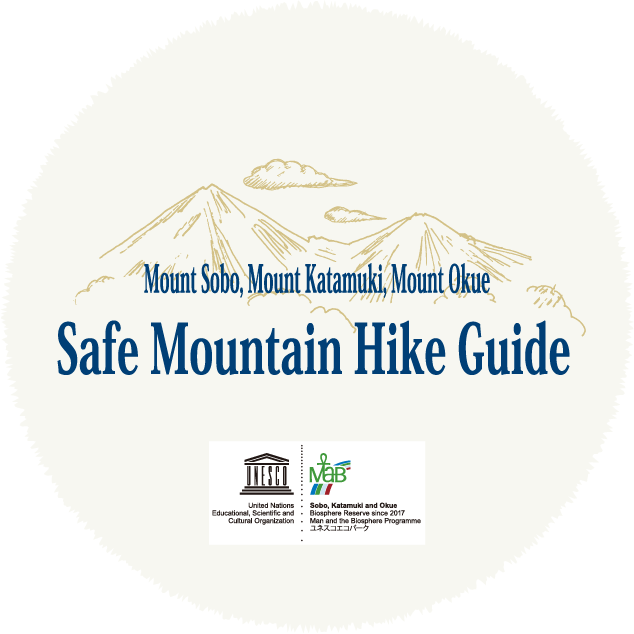
The Sobo, Katamuki, and Okue range stretches over Oita and Miyazaki prefectures. The unique landscape changes with the seasons, such as the rocky peaks rich in variety due to the influence of volcanic activity, the ancient forest that is a mixture of conifers and broad-leaved trees, and the diverse and valuable ecosystem, keep charming the visitors.
People living around the Sobo, Katamuki, and Okue range have respected the abundance of nature, utilized the blessings of, and lived while preserving these. Here, nature and humans coexist. This long-standing lifestyle has been highly acclaimed worldwide and was registered as a Biosphere Reserve in 2017.
* What is Biosphere Reserves?
A project started by UNESCO in 1976 to harmonize the conservation of ecosystems with sustainable utilization. The purpose is the human society to coexist with nature.

Preparation is vital to enjoying mountain hiking safely and comfortably. Mt. Sobo, Mt. Katamuki, and Mt. Okue are all high mountains with an altitude of 1,600 meters or more, so proper equipment and clothing are essential.

□ Raingear (top and bottom)
Be sure to carry it with you even if it is sunny. It can also be used as clothes to stay warm.
□ Shirt
Moisture wicking in summer and quick-drying plus heat-retaining in winter
□ Pants
Stretchy and comfortable to move in
□ Underwear
Quick-drying material
□ Socks
Thick mountain climbing socks and good to have a spare pair.
□ Hat
For protection from the sun and to protect the head. In the winter, a hat that cover ears.
□ Gloves
Lightweight for summer and heavy with heat retention for winter. Good to take a spare pair.
□ Coldweather garments
Fleecewear, sweaters, down jackets and others

□ Headlamp
A must for mountain climbing, and have spare batteries
□ Water bottle (for hydration)
Hydration is essential. Plan the amount to take according to how long your hike is.
□ Towel
Essential for drying sweat and washing
□ Toilet Paper
In case the mountain lodge or the starting point do not offer toilet paper.
□ Plastic bags
To put trash and dirty clothes in
□ Snacks
Food to eat while climbing
□ Emergency food
Food that can be preserved and ready to eat
□ Portable toilet
Something easily carried and able to take back

□ Backpack
About a 20 liter size for one day hikes
□ Backpack cover
To keep backpack dry
□ Trekking shoes
Made specifically for mountain climbing. Old shoes have a risk of the soles coming off
□ Map/compass
To use for location confirmation and action planning
□ Watch
Convenient if it is waterproof and can measure altitude and direction.

□ First aid items
Bandaids, disinfectants, bandages, supporters, medicine and so forth
□ Mobile phone
Means for emergency communication. Make sure it is charged and have a spare battery charger. Note that many areas in the mountain do not have service so know the areas where the phone will connect.
□ Health insurance card
This is required when seeing a doctor in case of injury or illness
□ Mountain climbing plan (mountain climbing application form)
Write your equipment, schedule, route, members, etc. and submit prior to the hike.
*Only basic equipment and items to take with you are listed here. Please make your own judgment and make proper preparations, according to the season and weather.

First of all, it is common sense to choose a course that suits your physical strength, skill, and experience.
Many places on the The Sobo, Katamuki, and Okue Range have poor visibility therefore do not go climbing with people who are inexperienced or go alone.
The basics of mountain climbing is "early departure/early arrival." In the summer, the weather changes quickly in the afternoon, and the sun sets early in the winter. Arrive at your destination early and plan your descent accordingly.
When you arrive at the starting point, check the weather and your physical condition. If you have issues at this point, do not climb the mountain.
The weather may suddenly change for the worse, or you don't feel well. If it doesn't feel right when you start climbing a mountain or think the route requires more physical strength than you expected, have the courage to turn back.
If by chance, you get lost, turning back the way you came is the basics. There is a danger of slipping in swamps and valleys, so do not go down. If you can't get back to the proper trail, save your strength where rescue teams can easily find you, such as an open area without trees or a ridge.

Climbers are basically prioritized when you pass another climber on a mountain trail. This is because it is easier to notice the other person on the descent and find a place to pass each other. Go to the mountainside instead of the valley side when you give way.
Precious alpine plants, including endangered species, grow naturally in the mountains. Do not walk off the trail to avoid trampling on such plants.
Take responsibility for all your trash generated during climbing. Peel off excess packaging such as food in advance to prevent excess garbage from being generated.
Basically, there are no toilets on the mountain trail; try to get your business done before the trail starting point. Note that if you stray too far from the trail to do business, you may slip or fall.
As mentioned above, there are basically no toilets in the mountains. Portable toilets are sold for a few hundred yen, so be prepared for emergencies
When you pass a person on a mountain trail, say hello. At the same time, if you have a few words like "The summit is just around the corner," communication will deepen. Not only does it give a good feeling, but it could also leave an impression on the other party, which can aid in searching in the unlikely event of an accident.
You might think, "it's only a small portion," but what if there are other people who feel the same? Never pick rare plants to prevent them from becoming extinct.
The Sobo, Katamuki, and Okue Range tower over the prefectural border between Oita and Miyazaki. Among Kyushu's famous mountains, the three peaks of "Mount Sobo," "Mount Katamuki," and "Mount Okue" have a charm that attracts climbers.
* Most of the mountain trails for each mountain are for intermediate and advanced users.
* In winter, it becomes slippery due to snow and freezing, so special equipment and caution are required.
* The time to the summit is the estimated time one-way.
Consider your physical strength and time to rest and plan with plenty of time.
A famous mountain representing Kyushu on the borders of Oita, Miyazaki, and Kumamoto prefectures was selected as one of the 100 famous mountains in Japan. Unlike Aso and Kuju, it is an old volcano, forming deep valleys and steep peaks. Depending on the altitude, you can enjoy the vegetation changing like the Tsuga Japanese sapphireberry community and the Beech Suzutake community.
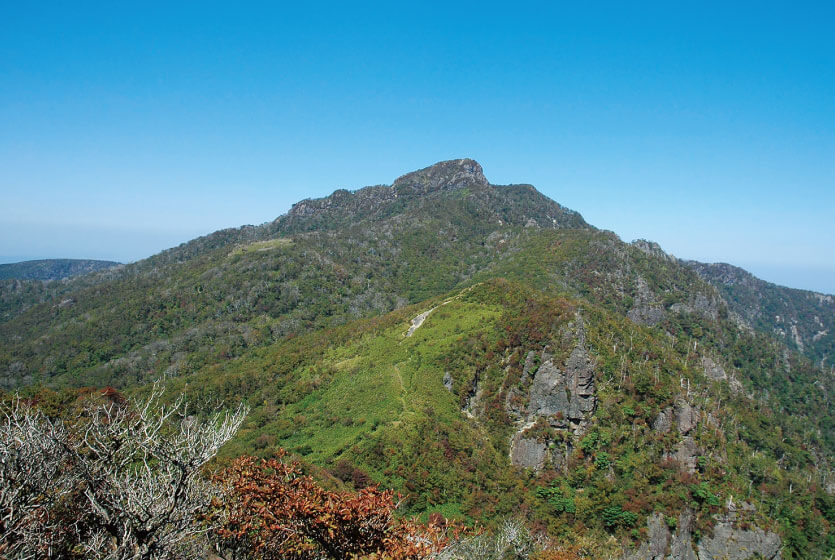
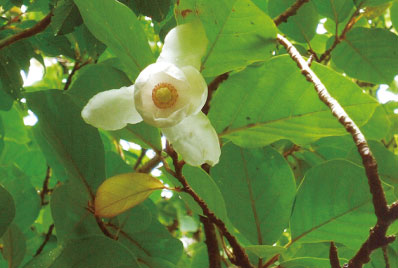
An elegant flower called "the lady of the forest" because of its downward blooming appearance and fragrant scent. The best time to see these at Mt. Sobo is around July.
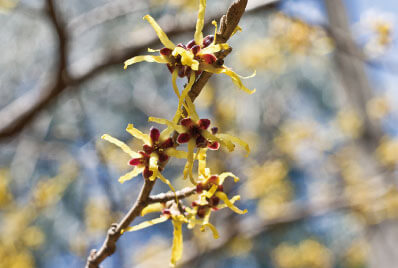
It is a flowering tree that blooms yellow flowers and announces the arrival of spring early in the season before trees start budding. The best time to see these in Mt. Sobo is around April.
○ Miyahara course
Physical fitness ★★★☆ / Degree of risks ★★☆☆ / 255 minutes to the summit
○ Kurogane One course
Physical fitness ★★★☆ / Degree of risks ★★★☆ / 275 minutes to the summit
* Ohira starting point: Wi-Fi available
Physical fitness ★★★☆ / Degree of risks ★★☆☆ / 210 minutes to the summit
Physical fitness ★★☆☆ / Degree of risks ★☆☆☆ / 150 minutes to the summit
This is another famous mountain with vertically steep cliffs around the summit alongside Mount Sobo. On the south side, the spectacular rocky mountains are Maekatamuki, Yoshisaku Ochi, Futatsubozu, and Mitsubozu. On the south, we see the Ushiro Katamuki creating a robust landscape.
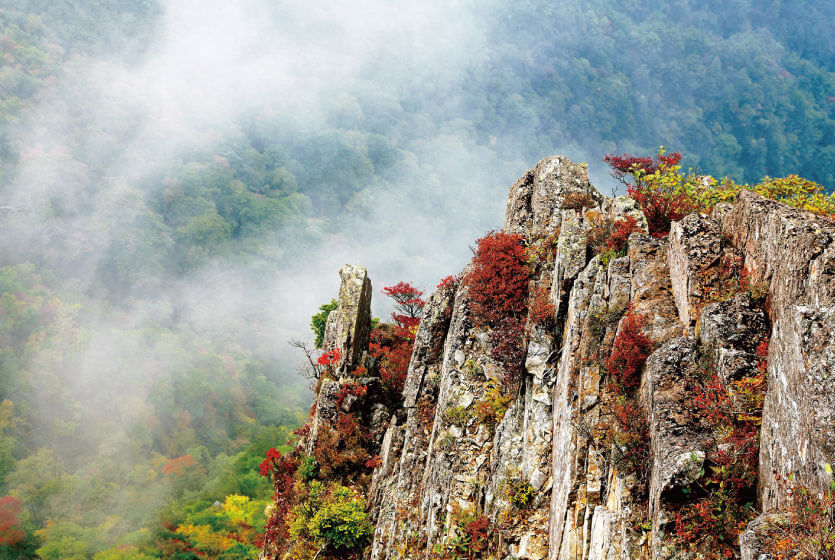
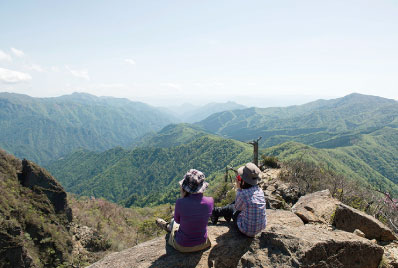
The summit consists of three unobstructed peaks on all sides. It overlooks Mt. Sobo, the Kuju mountain range, and Mt. Yufu.
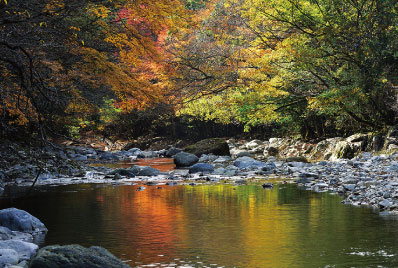
Here is a scenic valley that flows at the foot of Mount Katamuki. In autumn, where the trees turn bright red, the colors are breathtaking, and many people come from all areas visit.
Physical fitness ★★★☆ / Degree of risks ★☆☆☆ / 210 minutes to the summit
○ Via Bozu One
Physical fitness ★★★☆ / Degree of risks ★★★☆ / 315 minutes to the summit
○ Via Kuorikoshi Square
Physical fitness ★★★☆ / Degree of risks ★★☆☆ / 280 minutes to the summit
* Kuori Starting Point: Wi-Fi available
Physical fitness ★★★☆ / Degree of risks ★★☆☆ / 210 minutes to the summit
Physical fitness ★★★☆ / Degree of risks ★★☆☆ / 270 minutes to the summit
Physical fitness ★★☆☆ / Degree of risks ★☆☆☆ / 105 minutes to the summit
This famous peak is also referred to as "the last unexplored region of Kyushu." The untouched nature is attractive with all the cliffs, rocky peaks, and deep forests surrounding the valley. However, it is a mountain for advanced climbers. The mountain trail is long and steep, so it is recommended that you gain sufficient physical strength, gear, and experience before climbing. It is hazardous, especially in winter, because the rocks on the route freeze, so it is not advisable.
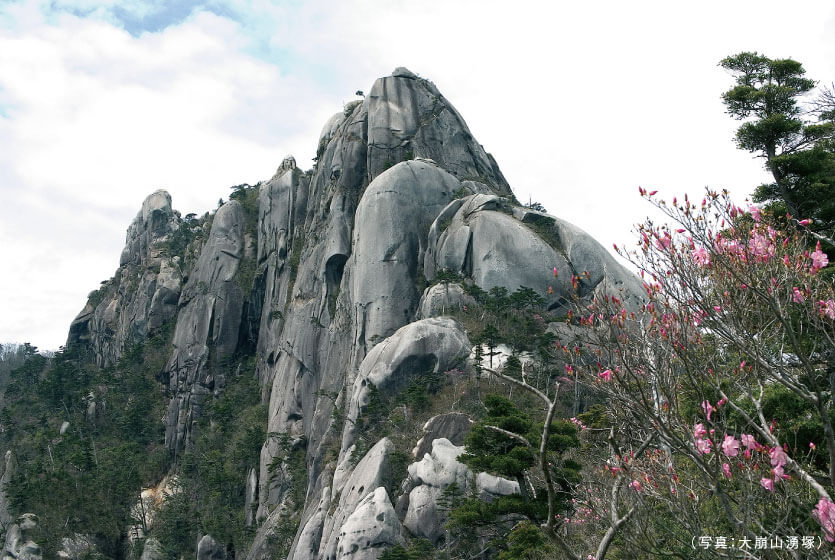
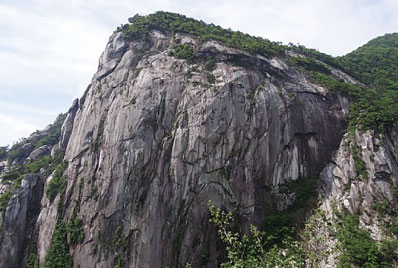
The rock peaks called Daki are dikes that rise from the underground due to volcanic activity and have an overwhelming presence, such as Sode Daki and Kozumi Daki. The rocks with distinctive shapes, such as Zo Iwa and Bozu Iwa, are also a must-see.
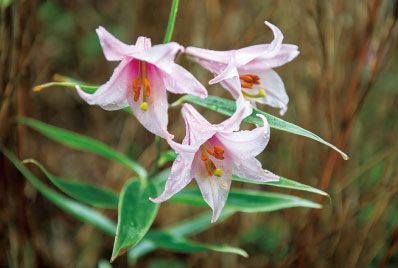
The pale pink flowers bloom in May-July.
Physical fitness ★★★★ / Degree of risks ★★★★ / 300 minutes to the summit
Physical fitness ★★★☆ / Degree of risks ★★★☆ / 180 minutes to the summit

The Sobo, Katamuki, and Okue mountain range, where the untouched forest remains, is characterized by a wide range of vegetation according to the altitude. Many rare animals and plants, such as the Japanese serow, designated as a special natural treasure, and the "Sohayaki element *" plant, which represents the origin of the Japanese archipelago. *Sohayaki element: A species endemic to Japan commonly distributed in the mountainous areas of Kii, Shikoku, and Kyushu, which became terrain a long time ago in the Japanese archipelago.
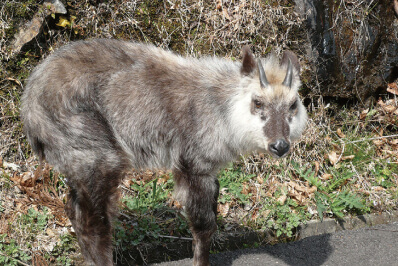
It is unique to Japan and is threatened with extinction in Kyushu. The Japanese serow is a nationally designated special natural treasure.
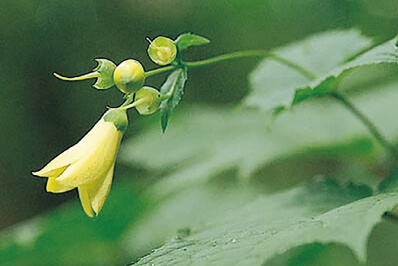
The yellow trumpet-shaped flowers bloom in July and August. Sohayaki element plant. (Photo: Osamu Hirano)
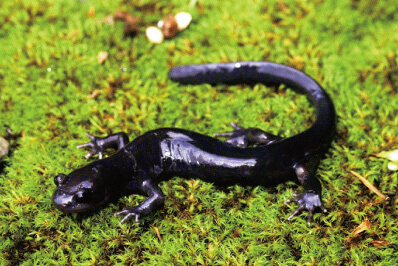
An endemic species that inhabits only the mountain streams of the Sobo, Katamuki, and Okue Mountains. (Photo courtesy of Bungoono City Nature History Friends Association)
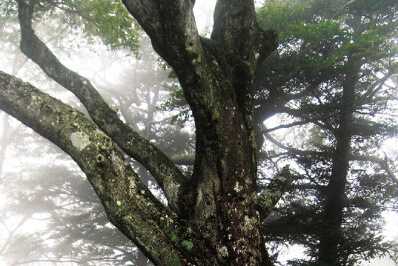
Found in Mount Okue of the Sobo, Katamuki, and Okue Range where the vertical distribution of various vegetation can be seen. (Photo: Takeshi Oda)
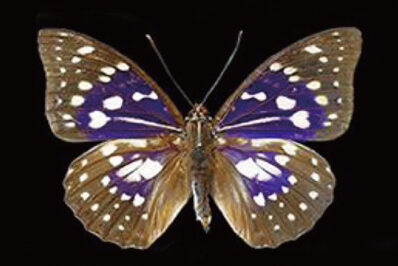
Has bright colors as its features and is also the national butterfly of Japan.
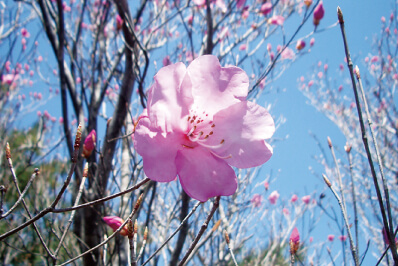
A Kyushu endemic species found in high mountains above 1,000 meters above sea level.
The rare flora and fauna of the Sobo, Katamuki, and Okue Range are in danger of extinction. If you see them in the mountains, never pick or harm them. Let us pass this rich natural environment to the future without damaging them.


Please check the websites of the Oita Prefectural Police and Miyazaki Prefectural Police. (Emergency contact information is also posted.)
Oita Prefectural Police website Miyazaki Prefectural Police website
Miyazaki Prefectural Police website